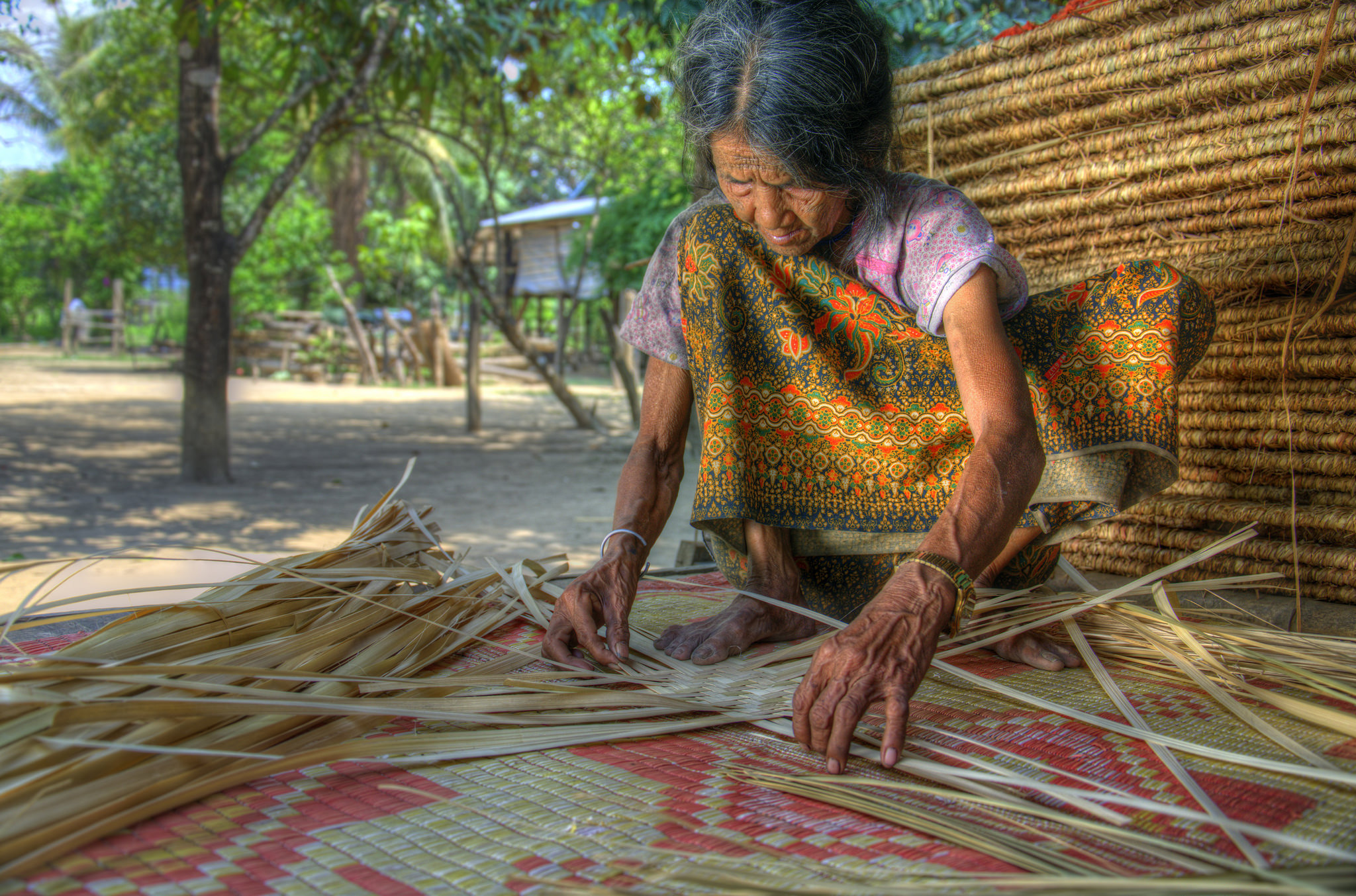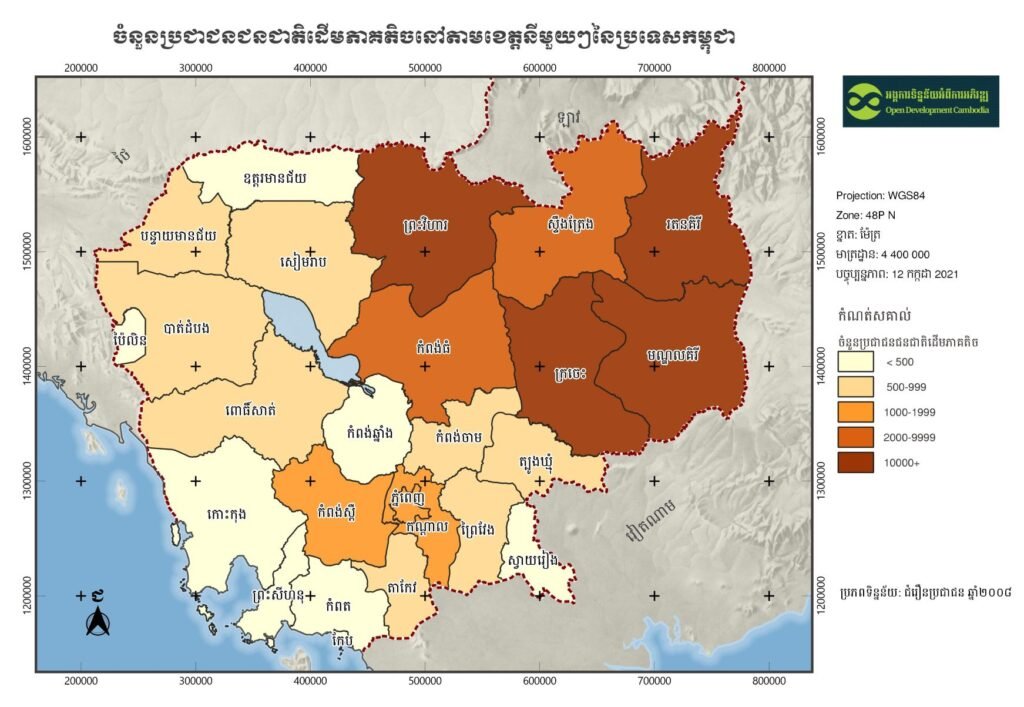យោងតាមជំរឿនប្រជាជនទូទៅឆ្នាំ២០១៩ របស់ព្រះរាជាណាចក្រកម្ពុជា ប្រជាជនកម្ពុជាសរុបមានចំនួនប្រមាណ ១៥.៥៥២.២១១នាក់ (ស្ត្រី ៥១,៣១ភាគរយ)។1 ចំនួនប្រជាជនបានកើនឡើងដល់ ១៦.៥៨៩.០២៣នាក់នៅឆ្នាំ២០២១។2 ជនជាតិវៀតណាម ចិន ចាម និងជនជាតិភាគតិចផ្សេងទៀតក៏រស់នៅក្នុងប្រទេសផងដែរ។ ជនជាតិដើមភាគតិចដែលគេស្គាល់ថា “ខ្មែរលើ” រស់នៅក្នុងប្រទេសកម្ពុជា ហើយរដ្ឋាភិបាលបានផ្តល់ដីមួយចំនួនដល់ពួកគេ រួមទាំងប័ណ្ណកម្មសិទ្ធិដីសមូហភាព ដូចមានចែងក្នុងអនុក្រឹត្យលេខ ៨៣ អនក្រ.បក ស្តីពីនីតិវិធីចុះបញ្ជីដីសមូហភាពជនជាតិដើមភាគតិច។3
គោលនយោបាលជាតិស្តីពីការអភិវឌ្ឍជនជាតិដើមភាគតិច បានឱ្យនិយមន័យ “ជនជាតិដើមភាគតិច គឺជាជនជាតិដែលរស់នៅលើដែនដីនៃព្រះរាជាណាចក្រកម្ពុជា ហើយជនជាតិទាំងនោះបង្ហាញនូវឯកភាពជាតិពន្ធុ សង្គម វប្បធម៌ និងសេដ្ឋកិច្ច ប្រតិបត្តិរបៀបរស់នៅតាមប្រពៃណី និងការដាំដុះលើដីដែលខ្លួនកាន់កាប់ទៅតាមក្បួនខ្នាត ទំនៀមទម្លាប់នៃការប្រើប្រាស់ដីជាសមូហភាព។”4

ស្ត្រីជនជាតិភាគតិចព្រៅកំពុងត្បាញកន្ទេលស្លឹកត្នោតនៅក្នុងខេត្តរតនគិរី ភាគឦសានប្រទេសកម្ពុជា។ រូបភាពដោយ Ethan Crowley, ថតនៅថ្ងៃទី ០១ ខែឧសភា ឆ្នាំ២០១២។ ក្រោមអាជ្ញារបណ្ណ CC BY-NC-SA 2.0
ប្រជាជនជនជាតិដើមភាគតិច
ជំរឿនប្រជាជនកម្ពុជាឆ្នាំ១៩៩៨ បានកំណត់អត្តសញ្ញាណជនជាតិដើមភាគតិចចំនួន ១៧ ផ្សេងៗគ្នា ដែលរស់នៅទូទាំង ១៥ ខេត្ត។ ពួកគេត្រូវបានគេប៉ាន់ស្មានថាមានចំនួនប្រហែល ២០០.០០០នាក់ ឬប្រហែល ១,២ភាគរយ នៃប្រជាជន។ ជារឿយៗ ក្រុមនេះត្រូវបានកំណត់អត្តសញ្ញាណតាមភាសារបស់ពួកគេ។5 យ៉ាងហោចណាស់មានភាសាជនជាតិដើមភាគតិចចំនួន ២១ នៅក្នុងប្រទេសកម្ពុជា។6
ជំរឿនប្រជាជនកម្ពុជាឆ្នាំ២០០៨ បានកំណត់អត្តសញ្ញាណជនជាតិដើមភាគតិចចំនួន ២២ ផ្សេងៗគ្នា ដែលមានចំនួនសរុបប្រមាណ ១៧៩.១៩៣នាក់។7 ជនជាតិដើមភាគតិចបានកើនឡើងដល់ ១៨៣.៨៣១នាក់ ក្នុងឆ្នាំ២០១៣។ ក្នុងឆ្នាំ២០១៤ ទិន្នន័យមូលដ្ឋានឃុំបានកំណត់អត្តសញ្ញាណជនជាតិដើមភាគតិចចំនួន ២៥២.៣៣៧នាក់ នៅក្នុងប្រទេសកម្ពុជា ហើយទិន្នន័យអង្កេតសេដ្ឋកិច្ចសង្គមបានបង្ហាញពីជនជាតិដើមភាគតិចចំនួន ២៤៣.៣៥៧នាក់ ក្នុងឆ្នាំ២០១៥។8 ទោះជាយ៉ាងណាក៏ដោយ អង្គការជនជាតិដើមភាគតិចកម្ពុជាបានកំណត់ចំនួនប្រជាជនសរុបប្រមាណ ២៧៦.៨៧៨នាក់ ដោយបែងចែកតាមក្រុមនីមួយៗ។ ក្រុមជនជាតិដើមភាគតិចកួយមានប្រជាជនភាគច្រើនជាងគេគឺមានប្រមាណ ២០,១២ភាគរយ នៃប្រជាជនជនជាតិដើមភាគតិចសរុប ហើយពួកគេរស់នៅក្នុង ១៣៥ភូមិ ទូទាំងប្រទេសកម្ពុជា។9 ជនជាតិដើមភាគតិចចំនួន ២២ក្រុម រួមមាន ព្នង ទំពួង កួយ ចារាយ គ្រឹង ព្រៅ ស្ទៀង កាវ៉ែត ក្រោល ចាអុង ព័រ មិល ល្មូន សួយ ខោញ គ្លឹង ស្អូច កាជ្រូក លុន រដែ មន និងកាចក់។10
ទីតាំងជនជាតិដើមភាគតិច
ជនជាតិដើមភាគតិចត្រូវបានរកឃើញនៅក្នុងខេត្តចំនួន ២២ ទូទាំងប្រទេសកម្ពុជា ដោយភាគច្រើននៃពួកគេប្រមូលផ្តុំនៅតំបន់ភាគខាងជើង និងឦសាន រួមមានខេត្តរតនគិរី មណ្ឌលគិរី ក្រចេះ ព្រះវិហារ និងខេត្តស្ទឹងត្រែង។ ការតាំងទីលំនៅរាយប៉ាយនៃជនជាតិដើមភាគតិចអាចសន្មត់ថាមកពី មុខរបរ ការអប់រំ អាពាហ៍ពិពាហ៍ និងកត្តាផ្សេងៗទៀត។11 សុខុមាលភាពយូរអង្វែងនៃវប្បធម៌ជនជាតិដើមភាគតិចត្រូវបានផ្សារភ្ជាប់យ៉ាងខ្លាំងទៅនឹងប្រព័ន្ធប្រើប្រាស់ដីរបស់ពួកគេ និងការទទួលបានផលពីធនធានព្រៃឈើ។ ពួកគេប្រកបរបរដាំដំណាំវិលជុំ និងចិញ្ចឹមសត្វ ហើយក្នុងព្រៃប្រមូលផលផ្តៅ និងវល្លិ ជ័រ ក្រវាញ និងទឹកឃ្មុំ។ ការត្បាញគឺជាប្រភពចំណូលសំខាន់មួយទៀត។ ប្រភពចំណូលខ្លះពឹងផ្អែកលើទៅតាមទីតាំង ដូចជាការជីកយករ៉ែត្បូងថ្មនៅខាងក្រៅក្រុងបានលុង ក្នុងខេត្តរតនគិរីជាដើម។

ចំនួនជនជាតិដើមភាគតិចនៅតាមខេត្តនីមួយៗនៃព្រះរាជាណាចក្រកម្ពុជា (យោងតាមស្ថិតិឆ្នាំ២០០៨)។
ច្បាប់ និងគោលនយោបាយ
ក្រសួងអភិវឌ្ឍន៍ជនបទ មានគោលនយោបាយជាតិស្តីពីការអភិវឌ្ឍសហគមន៍ជនជាតិដើមភាគតិច ដែលបានអនុម័តក្នុងឆ្នាំ ២០០៩។12 គោលនយោបាយនេះមានគោលដៅដើម្បីកែលម្អជីវភាពរស់នៅរបស់សហគមន៍ជនជាតិដើមភាគតិច និងដើម្បីលើកកម្ពស់គុណភាពនៃជីវិត។ គោលនយោបាយនេះផ្តោតទៅលើការអភិវឌ្ឍ ១០វិស័យ រួមមាន វប្បធម៌ ការអប់រំ និងបណ្តុះបណ្តាលវិជ្ជាជីវៈ សុខាភិបាល បរិស្ថាន ដីធ្លី កសិកម្មនិងធនធានទឹក ហេដ្ឋារចនាសម្ព័ន្ធ យុត្តិធម៌ ទេសចរណ៍ និងឧស្សាហកម្ម រ៉ែ និងថាមពល។
ច្បាប់ភូមិបាលឆ្នាំ២០០១ ផ្តល់សារៈសំខាន់យ៉ាងខ្លាំងសម្រាប់ការចុះបញ្ជីដីសមូហភាព ដូចមានចែងនៅក្នុងមាត្រា២៣ - ២៨។ មាត្រា ២៥ ចែងអំពីកម្មសិទ្ធិដីសមូហភាពសម្រាប់សហគមន៍ជនជាតិដើមភាគតិច ខណៈដែលមាត្រា២៦ ទទួលស្គាល់តួនាទីនៃអំណាច យន្តការ និងទំនៀមទំលាប់ ជាប្រពៃណី នៅក្នុងការធ្វើសេចក្តីសម្រេចចិត្ត និងការអនុវត្តនូវសិទ្ធិកម្មសិទ្ធិ។ យោងទៅតាមមាត្រា២៨ គ្មានអាជ្ញាធរណានៅក្រៅសហគមន៍អាចទទួលបានសិទ្ធិលើអចលនវត្ថុដែលជាកម្មសិទ្ធិរបស់ជនជាតិដើមភាគតិចបានឡើយ។
អនុក្រឹត្យស្តីពីនីតិវិធីនៃការចុះបញ្ជីដីសហគមន៍ជនជាតិដើមភាគតិច ត្រូវបានអនុម័តនៅក្នុងខែមិថុនា ឆ្នាំ២០០៩ ប៉ុន្តែវឌ្ឍនភាពមានសភាពយឺតយ៉ាវ ដោយសារតែភាពស្មុគស្មាញនៃដំណើរការនេះ៖
- ជាដំបូង ក្រសួងអភិវឌ្ឍន៍ជនបទចាំបាច់ត្រូវកំណត់អត្តសញ្ញាណនៃជនជាតិដើមភាគតិច និងសហគមន៍ជនជាតិដើម
- បន្ទាប់មក ក្រសួងមហាផ្ទៃចាំបាច់ធ្វើការចុះបញ្ជីសហគមន៍ជនជាតិដើមភាគតិចទាំងនោះជានីតិបុគ្គល
- បន្ទាប់មកទៀត ក្រសួងរៀបចំដែនដី នគរូបនីយកម្ម និងសំណង់ទទួលខុសត្រូវលើនីតិវិធីនៃការចេញប័ណ្ណកម្មសិទ្ធិដីសមូហភាព។ ការងារនេះពាក់ព័ន្ធនឹងការវាស់វែងអចលទ្រព្យ ដែលធ្វើឱ្យសំណើរមានភាពបើកទូលាយសម្រាប់សាធារណៈផ្តល់មតិនានា និងដើម្បីចេញប័ណ្ណកម្មសិទ្ធិ។
ខណៈដែលច្បាប់ភូមិបាលផ្តល់ការការពារយ៉ាងរឹងមាំសម្រាប់សហគមន៍ជនជាតិដើមភាគតិច អ្នកឃ្លាំមើលជាច្រើនបាននិយាយថា កង្វះខាតនៃការអនុវត្ត និងការពង្រឹងច្បាប់ជាក់ស្តែង បានធ្វើឱ្យសហគមន៍ជនជាតិដើមភាគតិចស្ថិតក្នុងស្ថានភាពងាយរងគ្រោះ ដោយសារប្រយោជន៍ពាណិជ្ជកម្ម និងរដ្ឋ ដែលទាក់ទាញការធ្វើអាជីវកម្មលើសក្តានុពលសេដ្ឋកិច្ចនៃព្រៃឈើ និងតំបង់ខ្ពង់រាប ដែលជាប្រពៃណី ត្រូវបានប្រើប្រាស់ និងគ្រប់គ្រងដោយសហគមន៍ជនជាតិដើមភាគតិច។13
គិតត្រឹមឆ្នាំ២០២២ សហគមន៍ជនជាតិដើមភាគតិចចំនួន ១៥២ បានចុះបញ្ជីជាមួយក្រសួងមហាផ្ទៃ ជានីតិបុគ្គល ហើយ ៩៤សហគមន៍ បានស្នើសុំប័ណ្ណកម្មសិទ្ធិដីសមូហភាពពីក្រសួងរៀបចំដែនដី នគរូបនីយកម្ម និងសំណង់។ សហគមន៍ចំនួន២៦ ត្រូវបានផ្អាកដោយសារបញ្ហាប្រឈមផ្សេងៗ។ សហគមន៍ជនជាតិដើមភាគតិចចំនួន ៣៨ ក្នុងខេត្តចំនួន ៤ បានទទួលប័ណ្ណកម្មសិទ្ធិដីសមូហភាពដែលមានចំនួនសរុប ៣៩.៣៤២ ហិកតា ក្នុងនោះមានខេត្តស្ទឹងត្រែង ២ សហគមន៍ ក្រចេះ ៤ សហគមន៍ មណ្ឌលគិរី ៧ សហគមន៍ និងរតនគិរី ២៥ សហគមន៍។14
ច្បាប់ស្តីពីព្រៃឈើឆ្នាំ ២០០២ បានលើកឡើងពីសិទ្ធិប្រើប្រាស់ជាប្រពៃណីលើផល និងអនុផលព្រៃឈើសម្រាប់សហគមន៍មូលដ្ឋាន15 និងផ្តល់មូលដ្ឋានច្បាប់ សម្រាប់សហគមន៍ រួមបញ្ជូលទាំងសហគមន៍ជនជាតិដើមភាគតិច ក្នុងការប្រើប្រាស់ និងជួយគ្រប់គ្រងព្រៃឈើ តាមរយៈសហគមន៍ព្រៃឈើ។ ខណៈដែលច្បាប់ស្តីពីព្រៃឈើផ្តល់មូលដ្ឋានច្បាប់សម្រាប់ព្រៃសហគមន៍ អនុក្រឹត្យស្តីពីការគ្រប់គ្រងសហគមន៍ព្រៃឈើឆ្នាំ ២០០៣ បានកំណត់ពីវិធានសម្រាប់ការបង្កើត ការគ្រប់គ្រង និងការប្រើប្រាស់ព្រៃទាំងនោះនៅក្នុងប្រទេសកម្ពុជា។
បញ្ហាប្រឈម និងបញ្ហាទាក់ទងនឹងសិទ្ធិដីធ្លី
ជនជាតិដើមភាគតិចប្រឈមមុខនឹងបញ្ហាប្រឈមសំខាន់ៗទាក់ទងនឹងការធានាសិទ្ធិដីធ្លី និងការដោះស្រាយវិវាទដីធ្លី រួមមាន៖
- ការទន្ទ្រានយកដី៖ សហគមន៍ជនជាតិដើមភាគតិចច្រើនតែទទួលរងនូវការទន្ទ្រានយកដីពីអ្នកខាងក្រៅ ដែលអាចនាំឱ្យមានការផ្លាស់ទីលំនៅ និងប៉ះពាល់ជីវភាពរស់នៅប្រចាំថ្ងៃ ក៏ដូចជាការបំផ្លាញទំនៀមទម្លាប់វប្បធម៌ផងដែរ។16
- ការការពារផ្នែកច្បាប់ខ្សោយ៖ ទោះបីជាសិទ្ធិដីធ្លីរបស់ជនជាតិដើមភាគតិចត្រូវបានការពារដោយស្របច្បាប់នៅក្នុងរដ្ឋធម្មនុញ្ញ និងច្បាប់ភូមិបាលរបស់កម្ពុជាក៏ដោយ ការការពារទាំងនេះជារឿយៗខ្វះខាតការអនុវត្ត ហើយសហគមន៍ជនជាតិដើមភាគតិចមានធនធានតិចតួចណាស់ នៅពេលដែលសិទ្ធិរបស់ពួកគេត្រូវបានរំលោភបំពាន។17
- កង្វះការពិគ្រោះ និងការចូលរួម៖ សហគមន៍ជនជាតិដើមភាគតិចនៅកម្ពុជា ជារឿយៗត្រូវបានដកចេញពីដំណើរការធ្វើសេចក្តីសម្រេចចិត្តលើការគ្រប់គ្រង និងអភិវឌ្ឍន៍ដីធ្លី។ នេះអាចនាំឱ្យមានវិវាទដីធ្លី និងជម្លោះ ក៏ដូចជាការបែកបាក់ទំនុកចិត្តរវាងសហគមន៍ជនជាតិដើមភាគតិច និងរដ្ឋាភិបាល ឬអង្គភាពផ្សេងៗ។18
ទាក់ទងនឹងជនជាតិភាគតិច និងជនជាតិដើមភាគតិច
- ដីធ្លី
- ដីសមូហភាព
- ការអភិវឌ្ឍ និងជំនួយសម្រាប់ជនជាតិភាគតិច និងជនជាតិដើមភាគតិច
- សមាគមជនជាតិភាគតិច និងជនជាតិដើមភាគតិច
- មូលនិធិអភិវឌ្ឍន៍សម្រាប់ជនជាតិភាគតិច និងជនជាតិដើមភាគតិច
- អង្គការមិនមែនរដ្ឋាភិបាលទទួលបន្ទុកផ្នែកអភិវឌ្ឍន៍សម្រាប់ជនជាតិភាគតិច និងជនជាតិដើមភាគតិច
- គោលនយោបាយ និងសិទ្ធិជនជាតិភាគតិច និងជនជាតិដើមភាគតិច
- ប្រវត្តិរូបជនជាតិភាគតិច និងជនជាតិដើមភាគតិច
ធ្វើបច្ចុប្បន្នភាព៖ ថ្ងៃទី០៣ ខែមីនា ឆ្នាំ២០២៣
ឯកសារយោង
- 1. វិទ្យាស្ថានជាតិស្ថិតិ, “ជំរឿនទូទៅប្រជាជននៅព្រះរាជាណាចក្រកម្ពុជាឆ្នាំ២០១៩៖ របាយការណ៍ជាតិស្តីពីលទ្ធផលជំរឿនចុងក្រោយ,” ក្រសួងផែនការ, ខែតុលា ឆ្នាំ២០២០, បានចូលអាននៅថ្ងៃទី២៧ ខែកុម្ភៈ ឆ្នាំ២០២៣។
- 2. ធនាគារពិភពលោក, “ប្រជាជនសរុប - កម្ពុជា,” បានចូលអាននៅថ្ងៃទី២៧ ខែកុម្ភៈ ឆ្នាំ២០២៣។
- 3. ទីស្តីការគណៈរដ្ឋមន្ត្រី, “អនុក្រឹត្យលេខ ៨៣ អនក្រ.បក ស្តីពីនីតិវិធីនៃការចុះបញ្ជីដីសហគមន៍ជនជាតិដើមភាគតិច” ចុះថ្ងៃទី ០៩ ខែមិថុនា ឆ្នាំ២០០៩, បានចូលអាននៅថ្ងៃទី២៧ ខែកុម្ភៈ ឆ្នាំ២០២៣។
- 4. ក្រសួងអភិវឌ្ឍន៍ជនបទ, “គោលនយោបាយជាតិស្តីអភិវឌ្ឍជនជាតិដើមភាគតិច” ថ្ងៃទី២៤ ខែមេសា ឆ្នាំ២០០៩, បានចូលអាននៅថ្ងៃទី២៧ ខែកុម្ភៈ ឆ្នាំ២០២៣។
- 5. ម៉ុល ផាត និង សេង សុវឌ្ឍនា, “កំណត់សម្គាល់បច្ចេកទេសប្រទេសស្តីពីបញ្ហាជនជាតិដើមភាគតិច៖ ព្រះរាជាណាចក្រកម្ពុជា,” IFAD/AIPP, ខែវិច្ឆិកា ឆ្នាំ២០១២, បានចូលអាននៅថ្ងៃទី០៣ ខែមីនា ឆ្នាំ២០២៣។
- 6. Ethnologue, “កម្ពុជា,” បានចូលអាននៅថ្ងៃទី០៣ ខែមីនា ឆ្នាំ២០២៣។
- 7. វិទ្យាស្ថានជាតិស្ថិតិ, “ជំរឿនទូទៅប្រជាជននៅព្រះរាជាណាចក្រកម្ពុជាឆ្នាំ២០០៨៖ របាយការណ៍ជាតិស្តីពីលទ្ធផលជំរឿនចុងក្រោយ,” ក្រសួងផែនការ, បានចូលអាននៅថ្ងៃទី២៧ ខែកុម្ភៈ ឆ្នាំ២០២៣។
- 8. ក្រសួងផែនការ និងក្រសួងអភិវឌ្ឍន៍ជនបទ, “របាយការណ៍អំពីស្ថានភាពប្រជាសាស្ត្រ និងសង្គម-សេដ្ឋកិច្ចរបស់ជនជាតិដើមភាគតិចកម្ពុជា,” ឆ្នាំ២០២១, បានចូលអាននៅថ្ងៃទី២៧ ខែកុម្ភៈ ឆ្នាំ២០២៣។
- 9. អង្គការជនជាតិដើមភាគតិចកម្ពុជា, “ទិន្នន័យជនជាតិដើមភាគតិច,” បានចូលអាននៅថ្ងៃទី២៧ ខែកុម្ភៈ ឆ្នាំ២០២៣។
- 10. ក្រសួងផែនការ និងក្រសួងអភិវឌ្ឍន៍ជនបទ, “របាយការណ៍អំពីស្ថានភាពប្រជាសាស្ត្រ និងសង្គម-សេដ្ឋកិច្ចរបស់ជនជាតិដើមភាគតិចកម្ពុជា,” ឆ្នាំ២០២១, បានចូលអាននៅថ្ងៃទី២៧ ខែកុម្ភៈ ឆ្នាំ២០២៣។
- 11. ក្រសួងផែនការ និងក្រសួងអភិវឌ្ឍន៍ជនបទ, "របាយការណ៍អំពីស្ថានភាពប្រជាសាស្ត្រ និងសង្គម-សេដ្ឋកិច្ចរបស់ជនជាតិដើមភាគតិចកម្ពុជា," ឆ្នាំ២០២១, បានចូលអាននៅថ្ងៃទី២៧ ខែកុម្ភៈ ឆ្នាំ២០២៣។
- 12. ក្រសួងអភិវឌ្ឍន៍ជនបទ, “គោលនយោបាយជាតិស្តីពីការអភិវឌ្ឍជនជាតិដើមភាគតិច,” ឆ្នាំ២០០៩, បានចូលអាននៅថ្ងៃទី០៣ ខែមីនា ឆ្នាំ២០២៣។
- 13. ម៉ុល ផាត និង សេង សុវឌ្ឍនា, "កំណត់សម្គាល់បច្ចេកទេសប្រទេសស្តីពីបញ្ហាជនជាតិដើមភាគតិច៖ ព្រះរាជាណាចក្រកម្ពុជា," IFAD/AIPP, ខែវិច្ឆិកា ឆ្នាំ២០១២, បានចូលអាននៅថ្ងៃទី០៣ ខែមីនា ឆ្នាំ២០២៣។
- 14. អង្គការទិន្នន័យអំពីការអភិវឌ្ឍ, "ប្លុក៖ កិច្ចប្រជុំចង្កោមអង្គការសង្គមស៊ីវិលលើកទី២," ថ្ងៃទី២៧ ខែធ្នូ ឆ្នាំ២០២២, បានចូលអាននៅថ្ងៃទី២៧ ខែកុម្ភៈ ឆ្នាំ២០២៣។
- 15. រាជរដ្ឋាភិបាលកម្ពុជា, “ច្បាប់ស្តីពីព្រៃឈើ (២០០២),” មាត្រា២, ឆ្នាំ២០០២, បានចូលអាននៅថ្ងៃទី០៣ ខែមីនា ឆ្នាំ២០២៣។
- 16. ប៊ុនលី សឿង, “យុទ្ធនាការ ឧក្រិដ្ឋកម្ម និងសម្បទាន៖ សិទ្ធិដីធ្លីជនជាតិដើមភាគតិចនៅកម្ពុជា,” new mandala, ថ្ងៃទី១១ ខែសីហា ឆ្នាំ២០២២, បានចូលអាននៅថ្ងៃទី២៧ ខែកុម្ភៈ ឆ្នាំ២០២៣។
- 17. Sarah Johnson, "ការកាប់ឈើខុសច្បាប់គំរាមកំហែងជនជាតិដើមភាគតិចនៅកម្ពុជា," The Guardian, ថ្ងៃទី២៨ ខែមករា ឆ្នាំ២០២២, បានចូលអាននៅថ្ងៃទី២៧ ខែកុម្ភៈ ឆ្នាំ២០២៣។
- 18. ក្រុមការងារអន្តរជាតិសម្រាប់កិច្ចការជនជាតិដើមភាគតិច, "ពិភពជនជាតិដើមភាគតិច," ថ្ងៃទី២៤ ខែមេសា ឆ្នាំ២០១៩, បានចូលអាននៅថ្ងៃទី២៧ ខែកុម្ភៈ ឆ្នាំ២០២៣។

